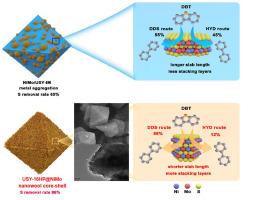Controllable assembly of NiMo nano-wool shell on zeolite Y and its advanced behavior of hydrodesulfurization toward dibenzothiophene
IF 4.7
3区 材料科学
Q1 CHEMISTRY, APPLIED
引用次数: 0
Abstract
A core-shell structured USY-xTT@NiMo catalyst was prepared through thermal treatment method and evaluated for the catalytic hydrodesulfurization (HDS) performance toward dibenzothiophene (DBT). The shell assembled from NiMoS nano-wool provided abundant active site. This nano-wool morphology and core-shell structure resulted in the catalyst with enhanced specific surface area, pore volume, lower interaction between the support and active metals, and facilitated metal dispersion. In addition, the nano-wool morphology and core-shell structure also promoted the degree of sulfurization and provided more sulfur vacancies, which enhanced the HDS performance of the corresponding catalysts. An efficient USY-16TT@NiMo catalyst with shorter slab lengths (average 2.50 nm), higher average stacking number (3.37 layers), and more edge active sites was assembled, which showed superior kHDS value of DBT up to 8.29 × 10−4 mol g−1 h−1 and high direct desulfurization selectivity to be 88 %.

沸石 Y 上镍钼纳米羊毛壳的可控组装及其对二苯并噻吩的先进加氢脱硫行为
通过热处理方法制备了一种核壳结构 USY-xTT@NiMo催化剂,并评估了其对二苯并噻吩(DBT)的催化加氢脱硫(HDS)性能。由 NiMoS 纳米棉组装而成的外壳提供了丰富的活性位点。这种纳米羊毛形态和核壳结构使催化剂具有更高的比表面积和孔隙率,降低了载体与活性金属之间的相互作用,并促进了金属的分散。此外,纳米絮状形态和核壳结构还提高了硫化程度,提供了更多的硫空位,从而增强了相应催化剂的加氢脱硫性能。组装出的高效 USY-16TT@NiMo 催化剂具有更短的板坯长度(平均 2.50 nm)、更高的平均堆积数(3.37 层)和更多的边缘活性位点,DBT 的 kHDS 值高达 8.29 × 10-4 mol g-1 h-1,直接脱硫选择性高达 88%。
本文章由计算机程序翻译,如有差异,请以英文原文为准。
求助全文
约1分钟内获得全文
求助全文
来源期刊

Microporous and Mesoporous Materials
化学-材料科学:综合
CiteScore
10.70
自引率
5.80%
发文量
649
审稿时长
26 days
期刊介绍:
Microporous and Mesoporous Materials covers novel and significant aspects of porous solids classified as either microporous (pore size up to 2 nm) or mesoporous (pore size 2 to 50 nm). The porosity should have a specific impact on the material properties or application. Typical examples are zeolites and zeolite-like materials, pillared materials, clathrasils and clathrates, carbon molecular sieves, ordered mesoporous materials, organic/inorganic porous hybrid materials, or porous metal oxides. Both natural and synthetic porous materials are within the scope of the journal.
Topics which are particularly of interest include:
All aspects of natural microporous and mesoporous solids
The synthesis of crystalline or amorphous porous materials
The physico-chemical characterization of microporous and mesoporous solids, especially spectroscopic and microscopic
The modification of microporous and mesoporous solids, for example by ion exchange or solid-state reactions
All topics related to diffusion of mobile species in the pores of microporous and mesoporous materials
Adsorption (and other separation techniques) using microporous or mesoporous adsorbents
Catalysis by microporous and mesoporous materials
Host/guest interactions
Theoretical chemistry and modelling of host/guest interactions
All topics related to the application of microporous and mesoporous materials in industrial catalysis, separation technology, environmental protection, electrochemistry, membranes, sensors, optical devices, etc.
 求助内容:
求助内容: 应助结果提醒方式:
应助结果提醒方式:


